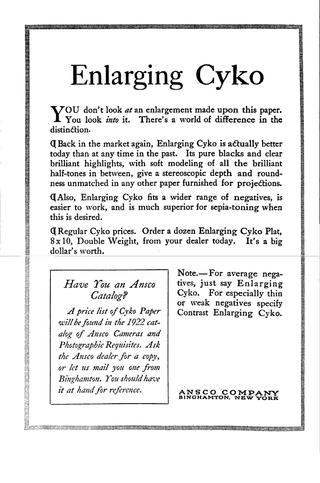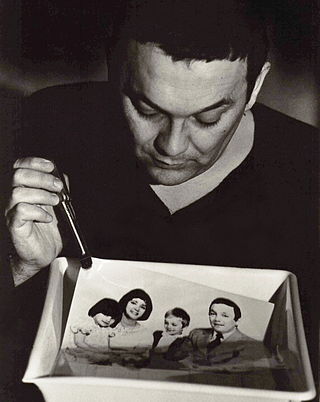Photographic processing or photographic development is the chemical means by which photographic film or paper is treated after photographic exposure to produce a negative or positive image. Photographic processing transforms the latent image into a visible image, makes this permanent and renders it insensitive to light.

Photographic paper is a paper coated with a light-sensitive chemical, used for making photographic prints. When photographic paper is exposed to light, it captures a latent image that is then developed to form a visible image; with most papers the image density from exposure can be sufficient to not require further development, aside from fixing and clearing, though latent exposure is also usually present. The light-sensitive layer of the paper is called the emulsion, and functions similarly to photographic film. The most common chemistry used is gelatin silver, but other alternatives have also been used.

In photography, reversal film or slide film is a type of photographic film that produces a positive image on a transparent base. Instead of negatives and prints, reversal film is processed to produce transparencies or diapositives. Reversal film is produced in various sizes, from 35 mm to roll film to 8×10 inch sheet film.

A darkroom is used to process photographic film, make prints and carry out other associated tasks. It is a room that can be made completely dark to allow the processing of light-sensitive photographic materials, including film and photographic paper. Various equipment is used in the darkroom, including an enlarger, baths containing chemicals, and running water.

Stop bath is an acidic solution used for processing black-and-white photographic films, plates, and paper. It is used to neutralize the alkaline developer, thus halting development.

A contact print is a photographic image produced from film; sometimes from a film negative, and sometimes from a film positive or paper negative. In a darkroom an exposed and developed piece of film or photographic paper is placed emulsion side down, in contact with a piece of photographic paper, light is briefly shone through the negative or paper and then the paper is developed to reveal the final print.

Instant film is a type of photographic film that was introduced by Polaroid Corporation to produce a visible image within minutes or seconds of the photograph's exposure. The film contains the chemicals needed for developing and fixing the photograph, and the camera exposes and initiates the developing process after a photo has been taken.

The Sabatier effect, also known as pseudo-solarization and erroneously referred to as the Sabattier effect, is a phenomenon in photography in which the image recorded on a negative or on a photographic print is wholly or partially reversed in tone. Dark areas appear light or light areas appear dark. Solarization and pseudo-solarization are quite distinct effects. Over time, the "pseudo" has been dropped in many photographic darkroom circles and discussions, but the effect that is meant is the Sabattier effect and not the solarization by extreme overexposure.

In photography, toning is a method of altering the color of black-and-white photographs. In analog photography, it is a chemical process carried out on metal salt-based prints, such as silver prints, iron-based prints, or platinum or palladium prints. This darkroom process cannot be performed with a color photograph. The effects of this process can be emulated with software in digital photography. Sepia is considered a form of black-and-white or monochrome photography.

Pyrogallol is an organic compound with the formula C6H3(OH)3. It is a water-soluble, white solid although samples are typically brownish because of its sensitivity toward oxygen. It is one of three isomers of benzenetriols.

The ADOX brand for photographic purposes has been used by three different companies since its original conception over one hundred fifty years ago. ADOX was originally a brand name used by the German company, Fotowerke Dr. C. Schleussner GmbH of Frankfurt am Main, the world's first photographic materials manufacturer. In 1962 the Schleussner family sold its photographic holdings to DuPont, an American company. DuPont used the brand for its subsidiary, Sterling Diagnostic Imaging for X-ray films. In 1999, Sterling was bought by the German company Agfa. Agfa did not use the brand and allowed its registration to lapse in 2003. Fotoimpex of Berlin, Germany, a company founded in 1992 to import photographic films and papers from former eastern Europe immediately registered the brand and today ADOX is a brand of black and white films, photographic papers and photochemistry produced by ADOX Fotowerke GmbH based in Bad Saarow near Berlin.

Harman Technology Limited, trading as Ilford Photo, is a UK-based manufacturer of photographic materials known worldwide for its Ilford branded black-and-white film, papers and chemicals and other analog photography supplies. Historically it also published the Ilford Manual of Photography, a comprehensive manual of everything photographic, including the optics, physics and chemistry of photography, along with recipes for many developers.
A chromogenic print, also known as a C-print or C-type print, a silver halide print, or a dye coupler print, is a photographic print made from a color negative, transparency or digital image, and developed using a chromogenic process. They are composed of three layers of gelatin, each containing an emulsion of silver halide, which is used as a light-sensitive material, and a different dye coupler of subtractive color which together, when developed, form a full-color image.

Analog photography, also known as film photography, is a term usually applied to photography that uses chemical processes to capture an image, typically on paper, film or a hard plate. These processes were the only methods available to photographers for more than a century prior to the invention of digital photography, which uses electronic sensors to record images to digital media. Analog electronic photography was sometimes used in the late 20th century but soon died out.

Tri-X is a black and white photographic film produced by the Eastman Kodak Company. Since 2013, it is distributed by Kodak Alaris which controls the Kodak Professional product line under which it is grouped. The combination of hand-held cameras and high-speed Tri-X film was transformative for photojournalism and for cinema.

Photographic film is a strip or sheet of transparent film base coated on one side with a gelatin emulsion containing microscopically small light-sensitive silver halide crystals. The sizes and other characteristics of the crystals determine the sensitivity, contrast, and resolution of the film. Film is typically segmented in frames, that give rise to separate photographs.

Neopan was originally a family of black-and-white films from Japanese manufacturer Fujifilm for both professional and amateur use. The range now only comprises one film; Neopan ACROS 100 II, a traditional silver halide black and white film re-launched in 2019 and currently sold worldwide.

Foma Bohemia is a photographic private limited company based in Hradec Králové, Czech Republic. It was established in 1921, originally as Fotochema, being renamed in 1995 on privatisation. They are mostly known for their line of black and white films and papers but also produce movie film, X-ray films for medicine and industry and personal dosimetry film along with processing chemicals. They formerly produced aerial and surveillance films.















